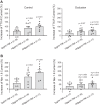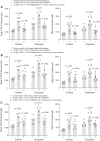Enhancement by TNF-α of TTX-resistant NaV current in muscle sensory neurons after femoral artery occlusion
- PMID: 32101460
- PMCID: PMC7191414
- DOI: 10.1152/ajpregu.00338.2019
Enhancement by TNF-α of TTX-resistant NaV current in muscle sensory neurons after femoral artery occlusion
Abstract
Femoral artery occlusion in rats has been used to study human peripheral artery disease (PAD). Using this animal model, a recent study suggests that increases in levels of tumor necrosis factor-α (TNF-α) and its receptor lead to exaggerated responses of sympathetic nervous activity and arterial blood pressure as metabolically sensitive muscle afferents are activated. Note that voltage-dependent Na+ subtype NaV1.8 channels (NaV1.8) are predominately present in chemically sensitive thin fiber sensory nerves. The purpose of this study was to examine the role played by TNF-α in regulating activity of NaV1.8 currents in muscle dorsal root ganglion (DRG) neurons of rats with PAD induced by femoral artery occlusion. DRG neurons from control and occluded limbs of rats were labeled by injecting the fluorescent tracer DiI into the hindlimb muscles 5 days before the experiments. A voltage patch-clamp mode was used to examine TTX-resistant (TTX-R) NaV currents. Results were as follows: 72 h of femoral artery occlusion increased peak amplitude of TTX-R [1,922 ± 139 pA in occlusion (n = 11 DRG neurons) vs. 1,178 ± 39 pA in control (n = 10), means ± SE; P < 0.001 between the 2 groups] and NaV1.8 currents [1,461 ± 116 pA in occlusion (n = 11) and 766 ± 48 pA in control (n = 10); P < 0.001 between groups] in muscle DRG neurons. TNF-α exposure amplified TTX-R and NaV1.8 currents in DRG neurons of occluded muscles in a dose-dependent manner. Notably, the amplification of TTX-R and NaV1.8 currents induced by TNF-α was attenuated in DRG neurons with preincubation with respective inhibitors of the intracellular signaling pathways p38-MAPK, JNK, and ERK. In conclusion, our data suggest that NaV1.8 is engaged in the role of TNF-α in amplifying muscle afferent inputs as the hindlimb muscles are ischemic; p38-MAPK, JNK, and ERK pathways are likely necessary to mediate the effects of TNF-α.
Keywords: NaV1.8 channels; TNF-α; dorsal root ganglion neuron; muscle afferent; peripheral artery disease.
Conflict of interest statement
No conflicts of interest, financial or otherwise, are declared by the authors.
Figures




Similar articles
-
Acid-sensing ion channel subtype 3 function and immunolabelling increases in skeletal muscle sensory neurons following femoral artery occlusion.J Physiol. 2012 Mar 1;590(5):1261-72. doi: 10.1113/jphysiol.2011.221788. Epub 2011 Dec 19. J Physiol. 2012. PMID: 22183722 Free PMC article.
-
Role for NGF in augmented sympathetic nerve response to activation of mechanically and metabolically sensitive muscle afferents in rats with femoral artery occlusion.J Appl Physiol (1985). 2012 Oct 15;113(8):1311-22. doi: 10.1152/japplphysiol.00617.2012. Epub 2012 Jun 28. J Appl Physiol (1985). 2012. PMID: 22744968 Free PMC article.
-
Tetrodotoxin-resistant sodium channels in sensory neurons generate slow resurgent currents that are enhanced by inflammatory mediators.J Neurosci. 2014 May 21;34(21):7190-7. doi: 10.1523/JNEUROSCI.5011-13.2014. J Neurosci. 2014. PMID: 24849353 Free PMC article.
-
TNF-α contributes to up-regulation of Nav1.3 and Nav1.8 in DRG neurons following motor fiber injury.Pain. 2010 Nov;151(2):266-279. doi: 10.1016/j.pain.2010.06.005. Epub 2010 Jul 17. Pain. 2010. PMID: 20638792
-
Nav1.8 neurons are involved in limiting acute phase responses to dietary fat.Mol Metab. 2017 Oct;6(10):1081-1091. doi: 10.1016/j.molmet.2017.07.012. Epub 2017 Aug 4. Mol Metab. 2017. PMID: 29031710 Free PMC article. Review.
Cited by
-
Lipopolysaccharide Modifies Sodium Current Kinetics through ROS and PKC Signalling in Induced Pluripotent Stem-Derived Cardiomyocytes from Brugada Syndrome Patient.J Cardiovasc Dev Dis. 2022 Apr 15;9(4):119. doi: 10.3390/jcdd9040119. J Cardiovasc Dev Dis. 2022. PMID: 35448095 Free PMC article.
-
Growth Differentiation Factor-15 Produces Analgesia by Inhibiting Tetrodotoxin-Resistant Nav1.8 Sodium Channel Activity in Rat Primary Sensory Neurons.Neurosci Bull. 2021 Sep;37(9):1289-1302. doi: 10.1007/s12264-021-00709-5. Epub 2021 Jun 2. Neurosci Bull. 2021. PMID: 34076854 Free PMC article.
-
Effects of bradykinin on voltage-gated KV 4 channels in muscle dorsal root ganglion neurons of rats with experimental peripheral artery disease.J Physiol. 2021 Jul;599(14):3567-3580. doi: 10.1113/JP281704. Epub 2021 Jun 11. J Physiol. 2021. PMID: 34036586 Free PMC article.
-
Amplified P2X3 pathway activity in muscle afferent dorsal root ganglion neurons and exercise pressor reflex regulation in hindlimb ischaemia-reperfusion.Exp Physiol. 2024 Apr;109(4):524-534. doi: 10.1113/EP091616. Epub 2024 Jan 11. Exp Physiol. 2024. PMID: 38213082 Free PMC article.
-
Emerging Molecular and Synaptic Targets for the Management of Chronic Pain Caused by Systemic Lupus Erythematosus.Int J Mol Sci. 2024 Mar 22;25(7):3602. doi: 10.3390/ijms25073602. Int J Mol Sci. 2024. PMID: 38612414 Free PMC article. Review.
References
Publication types
MeSH terms
Substances
Grants and funding
LinkOut - more resources
Full Text Sources
Research Materials
Miscellaneous

